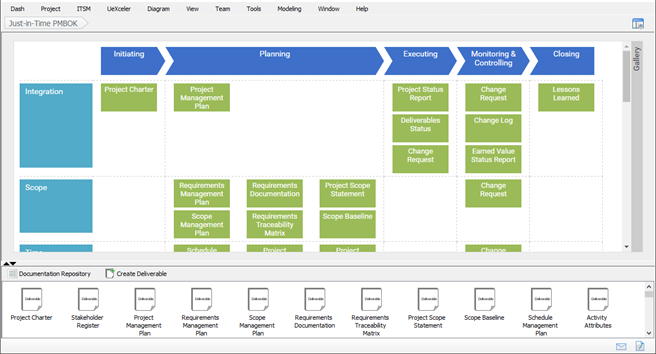The implementation phase is critical to ensure that the changes are made correctly and that everyone understands and follows them.
The implementation phase typically starts with the following steps:
- Communicate the changes to all affected employees. This should include a clear explanation of why the changes are being made, what they mean for employees, and when they will take effect.
- Train employees on how to follow the new policies or procedures. This training should be thorough and tailored to the specific changes that have been made.
Additional phases may be required to complete the implementation phase.
In a sequential phase-to-phase model, each phase starts when the previous phase is complete. The step-by-step nature of this approach reduces uncertainty but may limit options to reduce the schedule.
The image next shows a sequential phase-to-phase relationship.
In a simultaneous phase model, some or all phases are completed at the same time. Unlike the sequential phase-to-phase model, simultaneous completion of some phases can reduce the timeline.
In an overlapping phase-to-phase or schedule compression model, some phases start before the previous one is completed. Overlapping phases may reduce the timeline, but rework may be required if work progresses before required outputs are generated in the previous phase.
Despite your best efforts, things may go wrong during the implementation phase.
Also, things can and do change. Some of the most common impacting factors are included next.
New government legislation and/or industry regulations may be introduced or modify existing rules. Changes in government regulations can, in some circumstances, close the project down.
If there's been a health and safety incident/ accident or a change in organisational direction (like becoming more sustainable and environmentally conscious), a change in scope may be required to ensure compliance.
Where the business strategies change and/or finances are under review, the project could get shut down, or a change might be required to accommodate the change in direction.
If stakeholder requirements or customer demands change, project outcomes, timelines or quality changes may need consideration.
Technical updates, new software or enhanced hardware may affect the length of the project, delays in project deliverables or changes in the way services/ products as outcomes of the project will be made or processed.
A new or changed risk that has been identified and will need to be eliminated or addressed, so additional resources may be required.
Standard changes, customer expectation shifts and errors may result in delays and changes to the project scope.
Stakeholders can change their minds at any point throughout the project. If they decide there needs to be a change to the format or the quality of outputs, the scope will require a change.
Staff leaving the organisation or moving to another area can result in additional human resource requirements to achieve project goals.
Misunderstandings or inappropriate assumptions made in the initial stages may lead to poor outcomes and the requirement to redefine what's expected.
Changes will also be necessary when the project scope expands beyond the original parameters. To fix this problem, you will need to create a change management plan that outlines contingencies and approval strategies.
Some example contingencies and strategies to avoid project issues appear in the table.
| Problem | Reason | Options |
|---|---|---|
| A clear and concise scope statement was not provided | Project members need to be clear on what they are to do and when to minimise the chance of missing deadlines, running over budget, and making mistakes | Write a clear scope statement using a common language that everyone can understand Include boundaries of the project, role and responsibility of project team members, procedures for each phase of the project and the verification and approval process of each phase, task, or activity |
| Strengths and weaknesses of team members | Team members have inadequate skills for the project | Conduct a SWOT or similar exercise to identify the strengths and weaknesses of the team prior to the project beginning and be aware of and be ready for where the project may falter Select appropriate team members, arrange for coaching/mentoring team members, or recommend training |
| Lack of stakeholder engagement | Stakeholder satisfaction and involvement are critical for the successful completion of a project | Scope stakeholder expectations and requirements early in the project Confirm deliverables for meeting their requirements throughout the project |
| All required processes are not included in the project scope | Key deliverables and/or activities may be missed impacting budgets and timelines | Identify all work required using a WBS |
| The alignment of goals and objectives is poor | Vague and ambiguous goals make it difficult to know if an activity or task has been completed in full or as and when required | Check the activity/ task aligns with the project charter |
Typically, if a problem arises, team members are required to report to the project manager, who will generate a change to scope request like the example here.
Keep in mind that a lack of communication can lead to misunderstandings and conflicts among team members. To fix this problem, you will need to establish clear lines of communication and use tools like chat or video conferencing to ensure everyone is kept up to date.
Also remember, when deadlines are too tight, it puts pressure on team members, which can lead to mistakes and missed deadlines. To fix this problem, you will need to negotiate additional time to complete the work.
Critical decisions or changes must be made before issues become larger problems.
Take the following factors into account when managing changes:
- the time needed to approve additional time or resources
- working relationships and how well the project team work together
- training requirements to complete new or modified tasks
- access to resources like remote communication.
Non-critical decisions like allowing team members to work flexible hours must reflect organisational policies and procedures.
Take the following factors into account:
- the effect on morale
- the potential impact on project deadlines.
Good practice for change management means being open and honest about changes and processes.
Ensure that all changes are dealt with appropriately by having clear communication and the right processes and tools.
Read more about managing changes on projects.
The key steps and points to remember appear next.
| Steps | Points to remember |
|---|---|
| Receive request/ demand for change | Receive requests verbally, by phone, by email or on the change request form:
|
| Assess change request | Assess the impact of the change on:
|
| Prepare/ present recommendations for the change | Determine if the change:
|
| Obtain decision/decide to approve, reject or defer change | For changes within your authorisation limit, make decisions with input from the project team (change authorisation limits described in the requirements management plan) Sponsor, project committee or change control board decides on larger requests Make sure you:
|
Read the article here to learn more about managing budgets through changes in scope.

Collaborate with others
Collaboration is key to successful project management. By working with others, you can divide and conquer the work that needs to be done and ensure that all aspects of the project are accounted for. Additionally, by collaborating with others, you can build relationships and networks that can help you down the road. When choosing collaborators, it's important to select individuals who have the skills and knowledge necessary to complete the project successfully. You'll also want to make sure that everyone is on the same page with respect to deadlines, goals, and expectations. Working collaboratively can be challenging at times, but it's well worth the effort in the end.
Project management is all about getting work done efficiently and effectively. To do this, project managers must rely on collaboration methods to ensure everyone is on the same page. There are a variety of different methods that can be used, each with its own set of pros and cons.
The most common collaboration method is email. This method allows team members to easily communicate with one another by sending messages back and forth. However, email can be time-consuming and can lead to communication breakdowns if not used correctly.
Another common method is instant messaging. This allows team members to communicate in real-time, which can be helpful for troubleshooting problems or answering questions quickly. However, instant messaging can be disruptive if people are trying to work on other tasks.
A third option is video conferencing.
In topic two, we talked about Gantt charts as a way of managing project scope. We also discussed scope creep and explained that it could cause delays, budget overruns, and unhappy customers. Luckily, there are tools and techniques that project managers can use to identify and manage scope creep before it becomes problematic.
The image next shows that the user can access templates to suit each stage of the project.

If the business you work for uses a decision log, it might look like the example next. Instructions to use it are included in the template.
Note: In this example, the acronym ETC means estimated time of completion.
| Identifier | Date | Decision | Description | Impact | Rationale behind decision | Priority of decision | Status of decision | ETC | ||||
|---|---|---|---|---|---|---|---|---|---|---|---|---|
| Unique for this decision | Date decision entered | The decision (4 or 5 words) | Brief description of the decision | Brief description of impact if/if not decision is taken | The reason why a decision needs to be taken | H | M | L | Not started | In Progress | Completed | |
| 01 | DD/MM/YY | Engage new photographer | Search for a follow-up photographer | The project timeline will be impacted | Need photographs for the website | Y | Y | |||||
| 02 | DD/MM/YY | Extension to project timelines | User manuals delays – SMP to be updated | Budget is outside scope – $ needs to be increased | Need the manuals to meet scope deliverables | Y | Y | |||||
| 03 | DD/MM/YY | The Marino product was removed from the scope | The product cannot be produced in budget and without wastage | Whole product change Will affect budget, scope and schedule |
Additional time is needed in the schedule for market research and then Marino trials | Y | Y | |||||
Other tools are included in the table next.
| Scope Management Tools | |
|---|---|
| Gantt chart | A bar chart used to track tasks/activities across time and monitor interdependencies between the tasks/activities. It shows milestones, phases and resources for the tasks/activities as needed across the project life |
| PERT chart | PERT = Project Evaluation and Review Technique. It is a tool for analysing the tasks/activities for a project, working out the time needed to complete each task and identifying the minimum time required to complete the overall project |
| Product breakdown structure/analysis (PBS) | A PBS is a hierarchical structure that breaks down or decomposes the main products or deliverables of a project. Each product (output) will have its own criteria for acceptance and quality control methods as it moves through the levels in the hierarchy. A PBS enables clarification of the deliverables of the project and may contribute to a work breakdown structure |
| Work breakdown structure (WBS) | A WBS is a hierarchical structure for project tasks/activities with a focus on the work, not products needed to deliver the products or deliverables of the project. It is often likened to a ‘to-do list’. It breaks down the tasks/activities into manageable portions against which costs, and people can be scheduled |
| Project scope statement or statement of scope | A project scope statement or statement of scope is a documented base against which all project decisions are made and is used to direct the tasks/activities and direction of the project. It describes the main deliverables and sets the boundaries of the project, detailing what deliverables are ‘in scope’ or ‘out of scope’. The project scope may include key milestones, assumptions, and constraints |
| Template for the overall scope management plan | A template to use to document the scope management plan during a project’s planning phase. It has defined headings and description of what should be included under each heading such as the roles and responsibilities of stakeholders in the planning phase and scope management approaches and processes |
| Affinity diagram | An affinity diagram is a tool used to organise a large number of ideas and data. It can be used to generate ideas, organise and consolidate information related to complex issues, problems, process or products. It is often used in conjunction with brainstorming. To use, record ideas on notes/cards, look for related ideas and sort cards into groups until all have a place. |
| Mind maps | A mind map is a visual, non-linear diagram used to organise information by linking tasks, concepts or items around a central theme, concept or subject. |
| Traceability matrices | Traceability matrices are a tool used to ensure the project’s scope, deliverables and requirements are consistent with the originally designated baseline. It establishes a ‘connection’ or ‘thread’ for each requirement that can be traced from inception to completion |
| Status reports | Reports written at specific times during the project (weekly, monthly, fortnightly, daily) to outline the status and progress of the project. The times of reporting, for instance, will depend on the person requiring the reports, the problems or issues that need tracking, the set milestones for keeping track of the progress of the report |
Produce a project status report
Project status reports are a necessary part of any project manager's toolkit. They document the status of a project and its implementation phase and can be used to keep stakeholders apprised of progress and issues. A good status report should include a summary of the project so far, as well as descriptions of any problems or delays that have arisen. It should also outline what steps have been taken to address these issues and identify any risks that remain. Finally, it should provide a timeline for the upcoming phases of the project. A template for a project status report can be found online or created by the project manager.
Methods to measure work outcomes and progress against the project scope plan are included next:
- create performance criteria and/or targets against which a project team member, the project team or a project deliverable will be assessed against, – ideally, the assessment criteria should appear in the project charter or project scope management plan
- establish daily or weekly reporting
- review the Gantt chart each day, and communicate with team members if work milestones pass without a change in project status
- set incremental milestones if they haven't already been established
- complete a quality review to evaluate what's been done against set quality standards
- calculate the cost ratio based on the budgeted finance allocation versus the hours of labour used to complete a task or project
- benchmark the project against other projects or similar external work.
Note: Additional information about measuring work outcomes and progress is included in topic four.

